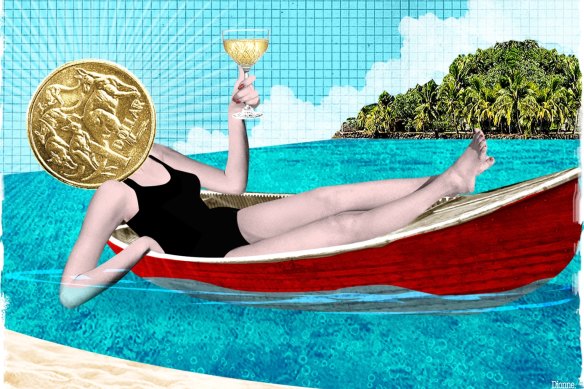This week, I was thoroughly gobsmacked when a press release landed on my (virtual) desk proclaiming that the “average” Australian has $40,000 of cash in the bank.
The figure, released by comparison website Finder, came from a nationally representative sample of more than 1000 Australians, and is up a whopping 75 per cent since March. It’s also at a record high since the company began tracking savings levels in May 2019.
$40,000 in savings? Must be nice.Credit:Dionne Gain
Forty thousand? The big four-oh? Who are these mythical beings with a huge pile of cash in the bank? Do they churn their own butter and grow their own lettuce? Have they not been to Europe this year?
It strikes a similar chord to the declaration from bank chief executives last week that there was still no sign of borrowers feeling the stress from higher interest rates, and the majority of customers are months ahead in their mortgage repayments. Really?
Australia is in a cost of living crisis, with inflation at a 21-year high of 6.1 per cent – and likely to rise by year-end – and a run of consecutive interest rate hikes which have put pressure on homeowners who weren’t lucky enough to fix their mortgage rates during the pandemic’s record lows.
Rents are at record highs in inner-cities and have risen at astronomical rates in regional towns. Energy prices are also at record highs, thanks in part to the war in Ukraine. Even the humble can of beans, once a cheap pantry staple, is 20 per cent more expensive.
I have some savings in the bank – less than $10,000 – but only because I took some equity out of my home loan when refinancing earlier this year to fund some renovations. Without that privilege, I’d likely be in the same position as many other people my age with perhaps a few thousand saved up. That’s a long way short of $40,000.
I’m not questioning the reliability of the data, nor the honesty of bank CEOs (although…). It’s common knowledge Australians did save like demons through the pandemic, with the Reserve Bank saying household savings increased by $260 billion.
With unemployment at its lowest level since the mid-70s and travel chaos and supply chain issues limiting what we can spend money on, many of us could well be sitting on Scrooge McDuck-style stacks of cash.
However, that doesn’t make it feel any less out of touch with our economic reality, or the lived reality of many Australians. Despite us being one of the most well-off countries in the world, wealth inequality is rife.
Who are these mythical beings with a huge pile of cash in the bank? Do they churn their own butter and grow their own lettuce?
The richest 10 per cent of households hold almost half of all wealth, while 60 per cent hold less than a fifth. We have the lowest unemployment payments out of any country in the OECD.
A recent study of NAB customers showed one-in-five Australians are seriously struggling to make ends meet, and one-in-two low-income earners faced some sort of financial hardship in the past three months.
Fiona Guthrie, chief executive of non-profit industry body Financial Counselling Australia, says she has been getting feedback from financial counsellors across the country that many people are seriously struggling.
“The people who are on low fixed incomes, like those on JobSeeker or pensions, there is no fat in those people’s budgets. So, when the cost of rent or petrol or utilities increases, they are forced to make impossible choices,” she says.
For those and many other low-to-middle income Australians, having $40,000 in the bank is nothing but a pipe dream.
Most Viewed in Money
From our partners
Source: Read Full Article


